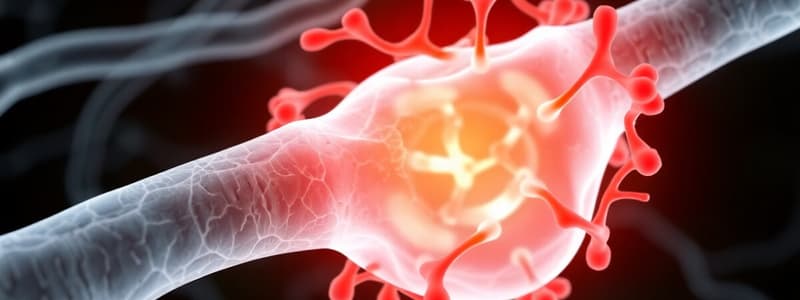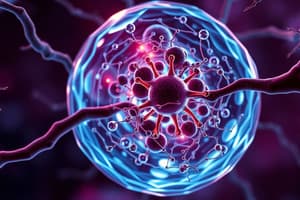Podcast
Questions and Answers
What is the primary function of oxidative phosphorylation (OXPHOS)?
What is the primary function of oxidative phosphorylation (OXPHOS)?
- To breakdown nutrients
- To produce glucose
- To maintain cellular homeostasis
- To generate adenosine triphosphate (ATP) (correct)
Disruptions in cellular homeostasis can lead to cellular dysfunction.
Disruptions in cellular homeostasis can lead to cellular dysfunction.
True (A)
What are NADH and FADH2 in the context of oxidative phosphorylation?
What are NADH and FADH2 in the context of oxidative phosphorylation?
They are high-energy molecules that donate electrons to the electron transport chain.
The main form of energy used by cells for powering functions is called ______.
The main form of energy used by cells for powering functions is called ______.
Match the following processes with their primary roles in cellular homeostasis:
Match the following processes with their primary roles in cellular homeostasis:
Where does oxidative phosphorylation occur within the cell?
Where does oxidative phosphorylation occur within the cell?
Cellular homeostasis does not influence overall organism health.
Cellular homeostasis does not influence overall organism health.
What is the consequence of prolonged disruptions in cellular homeostasis?
What is the consequence of prolonged disruptions in cellular homeostasis?
What is the final electron acceptor in the electron transport chain (ETC)?
What is the final electron acceptor in the electron transport chain (ETC)?
A deficiency in ATP production can lead to cellular energy surplus.
A deficiency in ATP production can lead to cellular energy surplus.
What process is responsible for the degradation and recycling of cellular components?
What process is responsible for the degradation and recycling of cellular components?
Disruptions in the oxidative phosphorylation (OXPHOS) pathway can lead to __________ conditions.
Disruptions in the oxidative phosphorylation (OXPHOS) pathway can lead to __________ conditions.
What is a potential consequence of increased production of reactive oxygen species (ROS)?
What is a potential consequence of increased production of reactive oxygen species (ROS)?
Autophagy is an irreversible process that only occurs during nutrient excess.
Autophagy is an irreversible process that only occurs during nutrient excess.
What are mitochondrial myopathies caused by?
What are mitochondrial myopathies caused by?
Cells recycle valuable molecules through __________ mechanisms.
Cells recycle valuable molecules through __________ mechanisms.
Match the following terms with their descriptions:
Match the following terms with their descriptions:
Which of the following is NOT a function of cellular cleanup processes?
Which of the following is NOT a function of cellular cleanup processes?
What is the role of BAX in the release of cytochrome C?
What is the role of BAX in the release of cytochrome C?
Survival factors enhance the release of cytochrome C from mitochondria.
Survival factors enhance the release of cytochrome C from mitochondria.
What protein complex is formed when cytochrome C associates with APAF1 and procaspase 9?
What protein complex is formed when cytochrome C associates with APAF1 and procaspase 9?
C-Myc-induced release of cytochrome C is suppressed by __________ and BCL-XL.
C-Myc-induced release of cytochrome C is suppressed by __________ and BCL-XL.
Match the apoptotic proteins with their roles:
Match the apoptotic proteins with their roles:
Which signaling pathway is involved in blocking c-Myc-induced apoptosis?
Which signaling pathway is involved in blocking c-Myc-induced apoptosis?
Inhibition of the mitochondrial pathway enhances c-Myc oncogenicity.
Inhibition of the mitochondrial pathway enhances c-Myc oncogenicity.
What is the primary function of the SUMO activating enzyme E1 in the sumoylation pathway?
What is the primary function of the SUMO activating enzyme E1 in the sumoylation pathway?
The sumoylation process is irreversible.
The sumoylation process is irreversible.
Name one medical condition associated with dysregulation of the sumoylation pathway.
Name one medical condition associated with dysregulation of the sumoylation pathway.
In humans, the conjugating enzyme involved in the sumoylation pathway is _____ .
In humans, the conjugating enzyme involved in the sumoylation pathway is _____ .
Match the diseases with their relation to the sumoylation pathway:
Match the diseases with their relation to the sumoylation pathway:
Which of the following processes is influenced by sumoylation in breast cancer?
Which of the following processes is influenced by sumoylation in breast cancer?
The sumoylation pathway uses the same enzymes as the ubiquitination pathway.
The sumoylation pathway uses the same enzymes as the ubiquitination pathway.
What is a hallmark feature of Alzheimer's disease linked to sumoylation?
What is a hallmark feature of Alzheimer's disease linked to sumoylation?
The E3 ligase in the sumoylation pathway is involved in attaching SUMO to the _____ .
The E3 ligase in the sumoylation pathway is involved in attaching SUMO to the _____ .
Which of the following enzymes is an example of E3 ligase?
Which of the following enzymes is an example of E3 ligase?
What is the primary function of Granzyme B?
What is the primary function of Granzyme B?
Granzyme A only targets core histones in the cell nucleus.
Granzyme A only targets core histones in the cell nucleus.
Name two types of immune cells that utilize the granule exocytosis pathway.
Name two types of immune cells that utilize the granule exocytosis pathway.
Granzyme B cleaves and activates the apical caspase, _____ as well as caspases 3, 6, and 7.
Granzyme B cleaves and activates the apical caspase, _____ as well as caspases 3, 6, and 7.
Match each caspase with its role in apoptosis:
Match each caspase with its role in apoptosis:
Which protein is cleaved by Granzyme B to induce oligonucleosomal DNA damage?
Which protein is cleaved by Granzyme B to induce oligonucleosomal DNA damage?
Granzyme B activates apoptosis solely through the caspase-dependent pathway.
Granzyme B activates apoptosis solely through the caspase-dependent pathway.
What role does truncated BID (tBID) play in the apoptotic process?
What role does truncated BID (tBID) play in the apoptotic process?
Cells that overexpress natural inhibitors of caspases such as BCL2 are _____ to granzyme B mediated apoptosis.
Cells that overexpress natural inhibitors of caspases such as BCL2 are _____ to granzyme B mediated apoptosis.
Which mechanism is NOT a known action of Granzyme B?
Which mechanism is NOT a known action of Granzyme B?
Flashcards
Cellular Homeostasis
Cellular Homeostasis
The maintenance of stable conditions in cells for optimal function, growth, and survival.
Importance of Homeostasis
Importance of Homeostasis
Maintaining cellular homeostasis prevents stress, dysfunction, and diseases, ensuring cell health.
Autophagy
Autophagy
A cellular process that degrades and recycles components, aiding in homeostasis.
Oxidative Phosphorylation
Oxidative Phosphorylation
Signup and view all the flashcards
ATP (Adenosine Triphosphate)
ATP (Adenosine Triphosphate)
Signup and view all the flashcards
Electron Transport Chain (ETC)
Electron Transport Chain (ETC)
Signup and view all the flashcards
Proton Gradient
Proton Gradient
Signup and view all the flashcards
NADH and FADH2
NADH and FADH2
Signup and view all the flashcards
Sumoylation pathway
Sumoylation pathway
Signup and view all the flashcards
SUMO protein
SUMO protein
Signup and view all the flashcards
E1 enzyme
E1 enzyme
Signup and view all the flashcards
E2 enzyme
E2 enzyme
Signup and view all the flashcards
E3 ligase
E3 ligase
Signup and view all the flashcards
De-sumoylation
De-sumoylation
Signup and view all the flashcards
Pathological aggregation
Pathological aggregation
Signup and view all the flashcards
Tau protein
Tau protein
Signup and view all the flashcards
Cell cycle regulation
Cell cycle regulation
Signup and view all the flashcards
Impact of sumoylation in cancer
Impact of sumoylation in cancer
Signup and view all the flashcards
ATP Synthase
ATP Synthase
Signup and view all the flashcards
Final Electron Acceptor
Final Electron Acceptor
Signup and view all the flashcards
Oxidative Phosphorylation (OXPHOS)
Oxidative Phosphorylation (OXPHOS)
Signup and view all the flashcards
Mitochondrial Myopathies
Mitochondrial Myopathies
Signup and view all the flashcards
Reactive Oxygen Species (ROS)
Reactive Oxygen Species (ROS)
Signup and view all the flashcards
Cellular Cleanup
Cellular Cleanup
Signup and view all the flashcards
Quality Control Mechanisms
Quality Control Mechanisms
Signup and view all the flashcards
Cellular Recycling
Cellular Recycling
Signup and view all the flashcards
Energy Starvation
Energy Starvation
Signup and view all the flashcards
Cytochrome C (CytoC)
Cytochrome C (CytoC)
Signup and view all the flashcards
BAX
BAX
Signup and view all the flashcards
Mitochondrial Outer Membrane Permeabilization (MOMP)
Mitochondrial Outer Membrane Permeabilization (MOMP)
Signup and view all the flashcards
APAF1
APAF1
Signup and view all the flashcards
Caspase 9
Caspase 9
Signup and view all the flashcards
BCL2/BCL-XL
BCL2/BCL-XL
Signup and view all the flashcards
c-Myc
c-Myc
Signup and view all the flashcards
Granzyme A
Granzyme A
Signup and view all the flashcards
Cytotoxic T lymphocytes (CTL)
Cytotoxic T lymphocytes (CTL)
Signup and view all the flashcards
Natural Killer (NK) cells
Natural Killer (NK) cells
Signup and view all the flashcards
Granule exocytosis pathway
Granule exocytosis pathway
Signup and view all the flashcards
Granzyme B
Granzyme B
Signup and view all the flashcards
Caspase activation
Caspase activation
Signup and view all the flashcards
BID protein
BID protein
Signup and view all the flashcards
Cytochrome C release
Cytochrome C release
Signup and view all the flashcards
DNA fragmentation
DNA fragmentation
Signup and view all the flashcards




